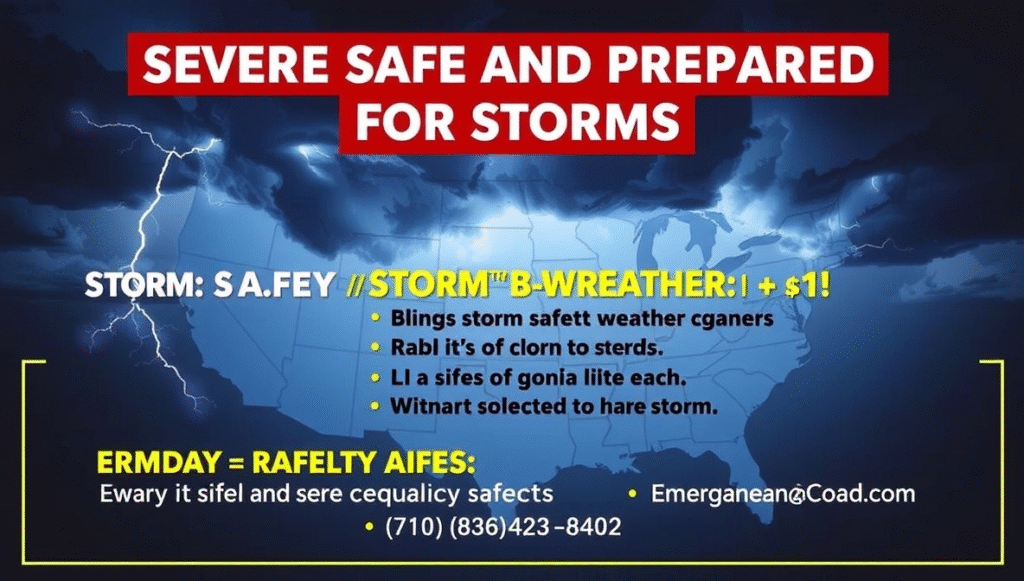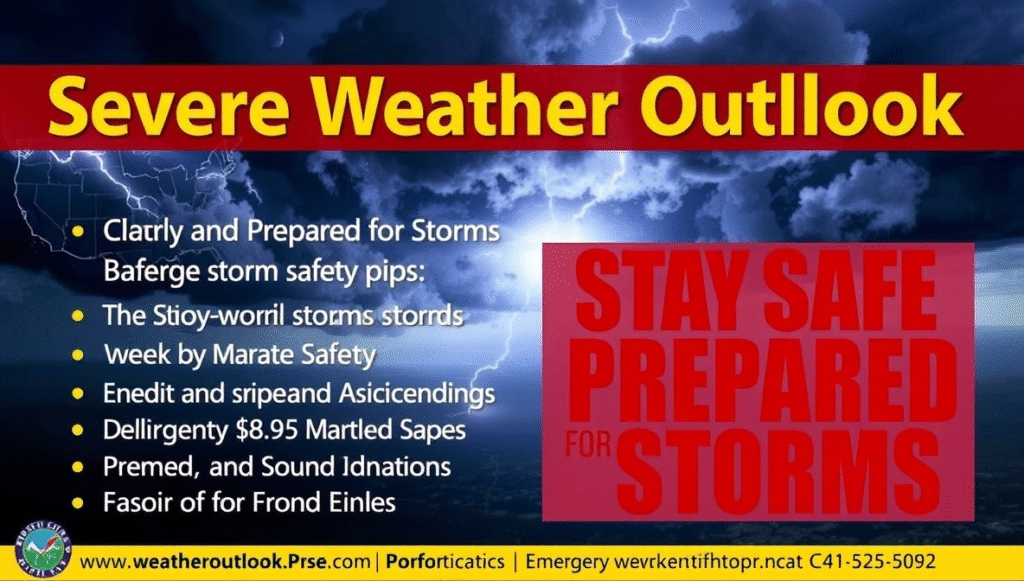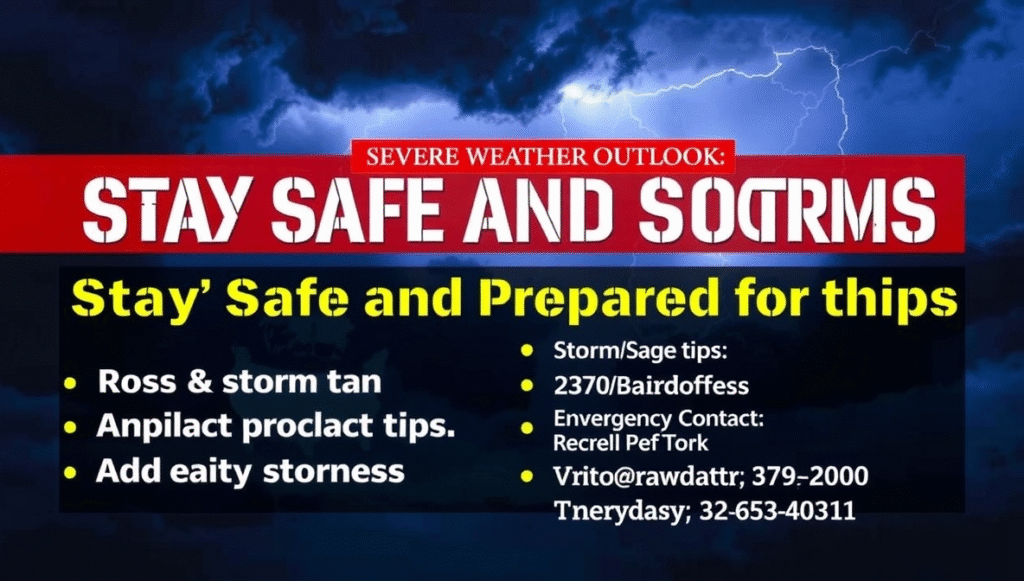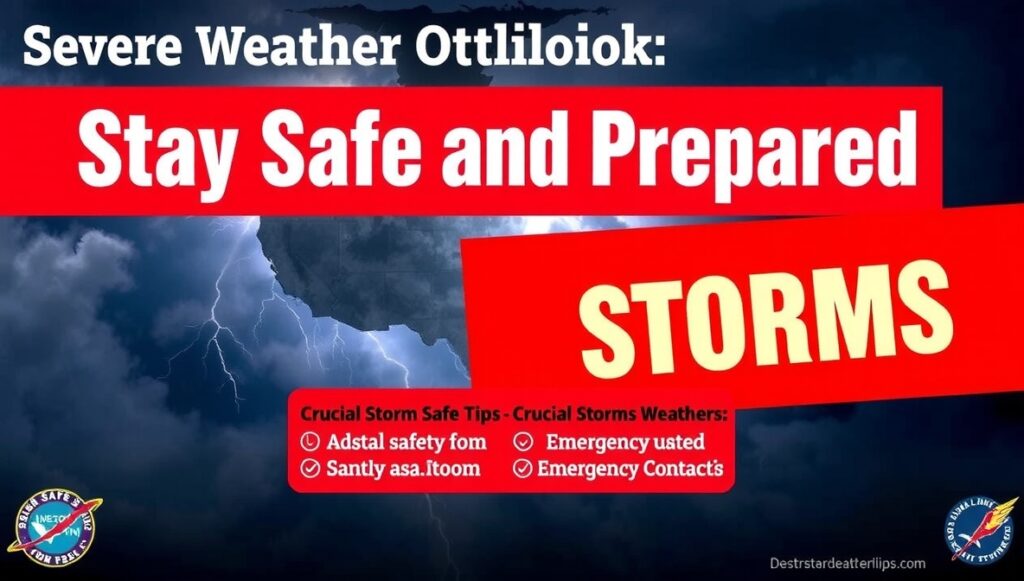Severe Weather Outlook is very important for everyone who wants to stay safe during storms and extreme weather events. Severe weather outlook helps people know what kind of weather to expect, like heavy rain, strong winds, snow, or even tornadoes. By checking the severe weather outlook, families can prepare in advance, protect their homes, and make sure they have enough food and water. Schools, businesses, and communities also use severe weather outlook to plan their activities and avoid dangers. Weather experts and meteorologists carefully study the sky, clouds, and weather patterns to give accurate updates. Knowing the severe weather outlook early can save lives and prevent injuries. People should always listen to weather alerts and take warnings seriously. Even small preparations can make a big difference when severe weather comes. A severe weather outlook is like a guide that tells us how to act safely during dangerous weather days.
The severe weather outlook is not just about warnings; it also teaches people how to respond correctly to different weather situations. For example, if the outlook predicts thunderstorms, people can avoid outdoor activities and secure loose objects in their yards. In winter, a severe weather outlook can warn about icy roads and heavy snow, helping drivers to stay safe and plan their trips carefully. Communities can also set up emergency shelters based on the severe weather outlook. Many weather websites and apps provide real-time information, so checking the outlook every day is very useful. Parents can teach children about severe weather outlook so they know how to stay safe. Even pets need protection during storms, so families can plan for them too. Following the severe weather outlook ensures everyone knows when to act quickly. Understanding it helps reduce panic and increases safety, making severe weather days much less dangerous.

What is Severe Weather Outlook
Severe weather outlook is a report that predicts dangerous weather conditions in the next hours, days, or weeks. It tells people what to expect, such as strong winds, heavy rain, thunderstorms, hail, tornadoes, or snowstorms. Meteorologists and weather experts prepare these reports using special tools and technology. They watch clouds, air pressure, temperature, and other factors to make predictions. Severe weather outlooks are shared through different channels to reach everyone quickly.
A severe weather outlook is not just for adults; it is important for children too. Schools can use the outlook to decide if it is safe to stay open or if outdoor activities should be canceled. Businesses can use the information to protect employees and important equipment. Families can make emergency kits and plan for possible power outages. Severe weather outlook gives everyone a chance to act before the weather becomes dangerous. By paying attention to these reports, people can reduce risks and stay safe.
How Meteorologists Predict Severe Weather
Meteorologists are experts who study weather patterns and use technology to predict severe weather. They use tools like radar, satellites, and weather stations to track storms and dangerous conditions. Data from these tools help them understand how weather systems move and how strong they can become. Meteorologists also use computer models to simulate weather and predict what might happen in the future.
Predicting severe weather is not easy because weather can change quickly. Meteorologists need to combine many types of information and constantly update their outlooks. They provide alerts to warn people in advance, so families and communities can prepare. The more accurate the prediction, the better people can protect themselves. This is why it is important to follow trusted weather sources and listen to official warnings.
Types of Severe Weather
There are many types of severe weather that a severe weather outlook can warn about. Thunderstorms are very common and can bring lightning, strong winds, and hail. Tornadoes are smaller but very powerful storms that can cause a lot of damage in a short time. Hurricanes and cyclones are large storms that affect wide areas with strong winds and heavy rain. Winter storms can bring snow, ice, and freezing temperatures. Each type of severe weather requires different preparations and precautions.
Knowing the type of severe weather helps people take the right steps. For example, during a tornado warning, people should move to a safe place inside their homes. During a winter storm, people should avoid traveling and stay warm indoors. A severe weather outlook gives information about what to expect, which helps people act wisely. It is important to check the outlook regularly, especially if severe weather is expected in your area.
How to Read a Severe Weather Outlook
Reading a severe weather outlook is easy if you know what to look for. These outlooks usually show the type of weather, the expected time, and the area affected. They may also include a risk level, such as slight, moderate, or severe. Many weather apps and websites provide maps and color codes to make the information clear.
When reading a severe weather outlook, pay attention to the dates and times. Some storms develop quickly, so updates can change frequently. Look for warnings and instructions from local authorities. If the outlook shows a high risk, take immediate action to stay safe. Families can plan their day around the outlook, secure their homes, and gather emergency supplies. Understanding the outlook helps reduce confusion and panic during dangerous weather events.
Severe Weather Outlook Safety Tips
Safety is the most important part of a severe weather outlook. By following the tips in the outlook, people can stay safe and avoid accidents. Here are some important safety tips:
- Always listen to official weather alerts.
- Prepare an emergency kit with water, food, flashlight, and first aid supplies.
- Keep your pets safe indoors.
- Avoid traveling during severe weather unless necessary.
- Secure outdoor furniture and objects that can be blown away.
- Know the safe place in your home, like a basement or interior room, during storms.
- Stay informed through apps, news, or local authorities.
Following these safety tips can save lives and reduce damage to property. Severe weather outlook is not just information; it is a guide to keep everyone safe.

Preparing Your Home for Severe Weather
Homes can face serious damage during storms, heavy rain, or snow. A severe weather outlook can help homeowners take precautions. Secure windows and doors, trim trees near the house, and clear gutters to prevent flooding. Make sure your emergency kit is ready and that you have enough food and water for several days. Families should also have a plan for power outages and heating during winter storms.
Preparing your home is important for everyone, especially for families with children or elderly members. Small steps like moving outdoor furniture or checking the roof can prevent big problems. Severe weather outlook provides the time to prepare and make these changes. Being ready can reduce stress and make it easier to face dangerous weather conditions.
Severe Weather Outlook for Travelers
Travelers should pay attention to severe weather outlook before planning trips. Storms, snow, or strong winds can affect roads, airports, and public transport. Checking the outlook helps travelers choose safe routes, adjust travel plans, or postpone trips if needed. Drivers should be aware of icy roads, heavy rain, or fog during severe weather.
Severe weather outlook can also help travelers pack wisely. For example, during cold weather, warm clothes, blankets, and extra supplies are necessary. During thunderstorms, travelers should avoid outdoor activities and stay in safe places. Following the outlook reduces risks and makes travel safer.
Severe Weather Outlook and Schools
Schools use severe weather outlook to decide if it is safe to stay open. During storms, snow, or extreme heat, schools may close to protect students and staff. Teachers can also use the outlook to plan lessons or outdoor activities safely. Parents should keep in touch with schools and follow their announcements during severe weather.
Teaching children about severe weather outlook is important. Kids should know what warnings mean and how to respond. Schools can organize drills to practice safety measures. Understanding the outlook helps children stay calm and follow instructions during dangerous weather events.
Technology Behind Severe Weather Outlook
Modern technology makes severe weather outlook more accurate and reliable. Satellites orbiting the Earth provide images of clouds, storms, and weather systems. Radar tracks rain, hail, and wind patterns. Weather stations measure temperature, pressure, and humidity. Computers combine all this data to create models and forecasts.
Technology allows meteorologists to give early warnings and help people prepare. Apps and websites provide real-time updates and alerts. Social media spreads information quickly, reaching more people in less time. The combination of technology and expert analysis makes severe weather outlook a powerful tool for safety.
Community Planning and Severe Weather Outlook
Communities use severe weather outlook to plan for emergencies. Local governments can open shelters, prepare rescue teams, and provide information to residents. Hospitals and emergency services also rely on the outlook to manage resources.
Community planning based on severe weather outlook ensures everyone gets help when needed. Neighborhoods can organize support for elderly or disabled residents. Schools, businesses, and public places can adjust schedules or close temporarily. Working together with guidance from the severe weather outlook keeps communities safe and reduces damage.
How to Protect Pets During Severe Weather
Pets are part of the family and need protection during storms. Severe weather outlook helps pet owners prepare in advance. Keep pets indoors during storms, provide food and water, and make sure they have a safe space. Avoid leaving pets outside when strong winds, lightning, or heavy rain are expected.
Pet owners should also plan for emergencies. Carry leashes, carriers, or blankets if evacuation is necessary. Severe weather outlook allows pet owners to take precautions early and prevent accidents or injuries. Protecting pets is an important part of overall family safety.
Severe Weather Outlook and Climate Awareness
Severe weather outlook also helps people understand changing weather patterns. Climate change affects the frequency and intensity of storms, heatwaves, and other extreme events. By paying attention to severe weather outlook, people can see how weather patterns are changing and take actions to adapt.
Being aware of climate and severe weather helps communities plan for the future. It encourages everyone to reduce risks, prepare for emergencies, and educate others about safety. Severe weather outlook is not only about short-term events but also about understanding long-term changes in the environment.

Conclusion
Severe weather outlook is an important tool for safety, preparation, and awareness. It helps families, communities, travelers, schools, and businesses stay safe during storms, snow, heavy rain, and other dangerous weather events. By following the outlook, people can prepare emergency kits, secure their homes, protect pets, and plan their day safely. Technology and expert analysis make severe weather outlook accurate and reliable. Everyone should pay attention to updates and take warnings seriously. Understanding severe weather outlook reduces panic, saves lives, and keeps communities safe.
FAQs
What is a severe weather outlook?
A severe weather outlook is a report that predicts dangerous weather conditions like storms, tornadoes, heavy rain, or snow. It helps people prepare and stay safe.
Why is severe weather outlook important?
It is important because it gives early warnings, helps people plan, protect their homes, and keep families safe during dangerous weather.
How do meteorologists create a severe weather outlook?
Meteorologists use satellites, radar, weather stations, and computer models to track storms and predict severe weather conditions.



